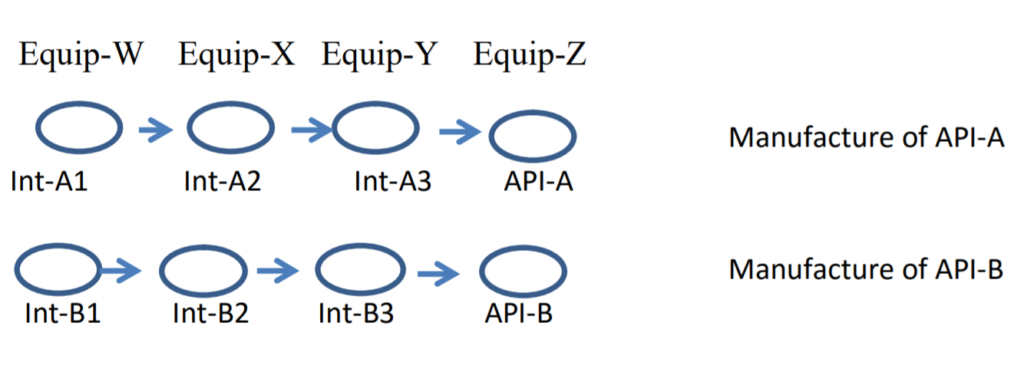This is a continuation of the April and May 2016 Cleaning Memos. If you haven’t read those (Part 1 and Part 2), please do so. In those previous Cleaning Memos we considered limits for intermediates, and discussed how to determine clearance of residues by subsequent processing steps. Now we’ll consider limits for cleaning of the final API.
As a visual aid, I will reproduce the schematic used in the previous two Cleaning Memos.

There are several examples that will be covered. The first involves the situation where I am cleaning API-A in Equip-Z, and the next process is another batch of API-A manufactured in Equip-Z. We have already discussed a similar situation from the perspective of intermediates, but in this situation the principle is the same. I shouldn’t be concerned about carryover of API from the previous batch except to the extent that such carryover interferes in some way with the synthesis reactions in that step. This concern is not likely, but if it is an issue, it should have been discovered in process development activities.
The next example involves manufacture of API-A in Equip-Z, and then after cleaning we manufacture API-B in Equip-Z. In this case, the limit calculation given in the April Cleaning Memo can be used. Furthermore, for the clearance factor, we can use the options presented in the May Cleaning Memo, with the proviso that we only look at the clearance of residues of API-A in the API-B synthesis step in Equip-Z.
The third example involves manufacture of API-A in Equip-Z, and then after cleaning we manufacture an intermediate (for example, Int-A2) from the same synthesis chain in Equip-Z. Provided that residues of API-A do not interfere with that earlier synthesis step, as well as subsequent steps (unless cleared), the concern of that residue (of API-A) ending up in another batch of API-A is probably minimal.
The fourth example involves manufacture of API-A in Equip-Z, and then after cleaning we manufacture an intermediate from a different synthesis chain (such as the one for API-B) in Equip-Z. In this situation, we should definitely consider the possibility that residues of API-A could end of in API-B. Limits calculations, including clearance factors for various subsequent steps, should be addressed.
So far we have considered cases where there may be clearance by subsequent process steps of residues left after cleaning. There may be steps, particularly for the API itself, where subsequent clearance does not occur. For example, after drying the final API we may then mill it to reduce the particle size (and for ease of handling). If I perform a cleaning process for the milling equipment, it is reasonable to assume that all residues left after cleaning will end up in the next product processed in the mill. In this case, the clearance factor (CF) is 1; that is, there is no clearance. Ordinarily this will only be an issue in going from one API to a different API on this type of equipment, thus making it one of the more critical cleaning steps in API manufacture.
An additional topic to address is whether firms should set reasonable “default” values for residues either of intermediates or of other APIs in the final API. These default values can be used in carryover calculations if the default value is a lower concentration in the final API than a concentration calculated by either a health-based or dose-based criterion. While the typical default value for drug product manufacture has been 10 ppm, I have generally advocated a higher default value for API manufacture (values closer to 50 ppm or 100 ppm) based on the fact that if the percentage of API in the formulated drug product is less than 5%, either of those default values in the API will result in a value well below 10 ppm in a drug product formulated with that API.
A final topic to consider in setting limits for cleaning in the various synthesis steps for an API is whether it makes sense to set limits for the total amount of residues carried over from cleaning processes and not cleared, which could end up in the final API. Care needs to be used in trying to address this, because while we measure residues left after cleaning, we generally don’t measure every possible residue. In addition, this may already be dealt with by using ICH Q3A, dealing with impurities in new drug substances. If limits are set using a default of no more than 100 ppm in the final API, it is likely that any individual cleaning residue would be below the reporting thresholds of either 0.05% (500 ppm) or 0.03% (300 ppm) set by ICH Q3A. If a default value is not used, it may be that limits are set above a Q3A reporting value, which is another possible reason for establishing a reasonable default value. The only other cases where this might be an issue are where there are multiple independent sources of given cleaning residue based on a complex manufacturing scheme, such that the cumulative residue (if not cleared) may total more than the Q3A reporting value.
This is the final Cleaning Memo in the series on limits for small molecule API synthesis. We have covered general principles as well as some specific examples. I want to emphasize that application to any specific manufacturing situation requires understanding of those manufacturing processes, and then use of judgment and wisdom is applying these principles appropriately.